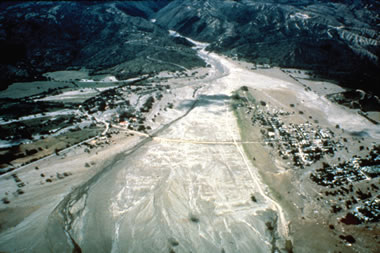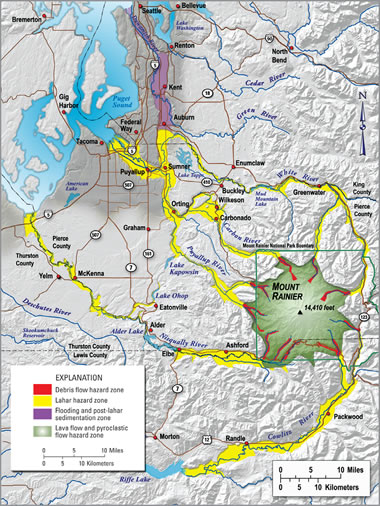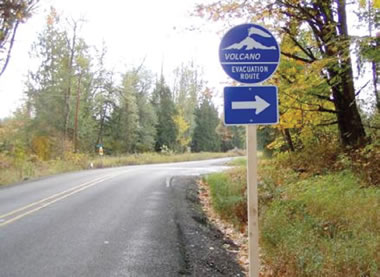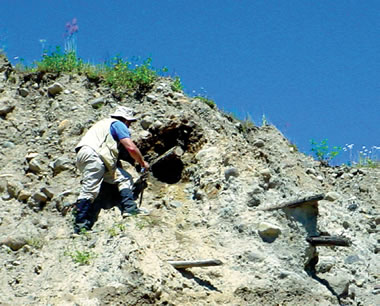When Will Mt Rainier Erupt Again
Habitation » Volcanoes » Mount Rainier - Living Safely with a Volcano
Mount Rainier - Living Safely With a Volcano in Your Backyard
Past Carolyn Fifty. Driedger and William Eastward. Scott, USGS -- Republished from USGS fact sheet 2008-3062.

Mount Rainier: The flat floor of the Puyallup River valley near Orting, Washington, is formed past deposits of the 500-year-old Electron lahar, which surged down from Mount Rainier (in background). Lahars, or volcanic mudflows, are rapidly flowing slurries of mud and boulders that destroy or bury near manmade structures in their paths. Lahars from Mount Rainier tin can travel for tens of miles along river valleys and accomplish Puget Sound. (USGS photo by D.E. Wieprecht.)
U.S. Geological Survey (USGS) research shows that Mount Rainier is i of our Nation's almost dangerous volcanoes. It has been the source of endless eruptions and volcanic mudflows (lahars) that have surged down valleys on its flanks and buried broad areas now densely populated. To aid people live more safely with the volcano, USGS scientists are working closely with local communities, emergency managers, and the National Park Service.
An Agile Volcano at Rest
Between Eruptions
Mount Rainier, an active volcano currently at residual betwixt eruptions, is the highest peak in the Pour Range. Its edifice, capped by snowfall and 25 glaciers, has been built up past untold eruptions over the past 500,000 years. It final erupted in 1894-95, when small meridian explosions were reported by observers in Seattle and Tacoma. Mount Rainier'southward next eruption might be of like or larger size and could produce volcanic ash, lava flows, and avalanches of intensely hot rock and volcanic gases, called "pyroclastic flows."
Some of these events swiftly cook snowfall and water ice and could produce torrents of meltwater that selection upwards loose rock and go rapidly flowing slurries of mud and boulders known equally "lahars." In contrast to lava flows and pyroclastic flows that are unlikely to extend farther than 10 miles from the volcano's pinnacle and remain within Mount Rainier National Park, the largest lahars can travel for tens of miles and reach Puget Sound.
Volcanic ash will be distributed downwind, nearly frequently toward the east, away from Puget Sound's large population centers. Airborne plumes of volcanic ash tin can greatly endanger aircraft in flight and seriously disrupt aviation operations. Although seldom life threatening, volcanic ash fallout on the ground tin can be a nuisance to residents, touch utility and transportation systems, and entail substantial make clean-upwards costs.

Armero, Colombia, was battered in 1985 by lahars generated past an eruption of glacier-clad Nevado del Ruiz volcano. More than 20,000 people died in the city. Note empty street blocks where structures were swept away. Tragically, safety lay nearby in areas of college ground. (USGS photograph by R.J. Janda.)
Lahars Pose the Greatest Gamble
At Mount Rainier, the risk from lahars is greater than from lava flows, volcanic ash autumn, or other volcanic phenomena because some pathways for future lahars are densely populated and incorporate important infrastructure such as highways, bridges, ports, and pipelines. Lahars look and behave like flowing concrete, and they destroy or bury almost manmade structures in their paths. Past lahars probably traveled 45 to 50 miles per hour and were as much as 100 feet or more thick where confined in valleys near the volcano. They thinned and spread out in the wide valleys downstream, slowing to xv to 25 miles per hour. Deposits of past lahars are establish in all of the valleys that get-go on Mount Rainier'south flanks.
ADVERTISEMENT
Mountain Rainier Lahar and Flows Map

Mount Rainier take a chance zones: This map shows areas that could exist affected by debris flows, lahars, lava flows, and pyroclastic flows from Mount Rainier if events similar in size to past events occurred today. Considering pocket-size lahars are more than common than big ones, most lahars would be less all-encompassing than the hazard zone shown on the map and a few would be more extensive. The lahar take a chance is not equal in all valleys. For case, the greatest hazard from lahars generated by landslides is on the west side of the volcano because it contains the largest amount of hydrothermally weakened rock. Scientists go on to reevaluate the run a risk zones as they learn more almost the volcano. Dams and reservoirs on several rivers could lessen the extent of hereafter lahars by trapping all or much of the menses, only they could also increase a lahar'southward extent if a lahar displaced reservoir water and caused dams to fail. A zone of flooding and postal service-lahar sedimentation is shown only in the Green and Duwamish River valleys (meet Long-Term Effects of Lahars), because in other valleys it is included in the lahar hazard zone. Night greyness shading indicates urbanized areas. (Map simplified from U.S. Geological Survey Open-File Report 98-428.) Larger Map.
How Hazardous is Mount Rainier?
Mount Rainier has erupted less oft and less explosively in recent millennia than its well-known neighbour, Mountain St. Helens. However, the proximity of large population centers in valleys susceptible to lahars from Mount Rainier makes it a far greater threat to life and property than Mount St. Helens for the following reasons:
Population and development at risk: Most 80,000 people and their homes are at risk in Mountain Rainier's lahar-risk zones. Key infrastructure such every bit major highways and utilities cross through these zones, which also comprise economically of import businesses, hydroelectric dams, and major seaports.Size and frequency of lahars: During the by several grand years big lahars have reached the Puget Audio lowland on average at to the lowest degree once every 500 to 1,000 years. Smaller flows non extending as far as the lowland occurred more frequently. If future large lahars happen at rates similar to those of the past, there is roughly a 1-in-10 chance of a lahar reaching the Puget Audio lowland during an average man lifespan.
In that location may exist little or no accelerate alert: Studies by U.Southward. Geological Survey (USGS) scientists show that at least ane of Mount Rainier's recent large landslide-generated lahars may have occurred when the volcano was tranquility and not providing the warning signs typical of a restless and erupting volcano. In such a rare case, the but warning could be a report that a lahar is already underway.
Two Types of Lahars
Mountain Rainier can generate two types of lahars that can threaten surrounding valleys:
Meltwater-generated lahars: Mount Rainier supports more than than i cubic mile of glacial ice-as much as all other Cascade Range volcanoes combined. During past eruptive episodes, swift melting of snow and ice by pyroclastic flows and other events caused numerous lahars. Such lahars would be preceded by events that warn of an impending eruption.Landslide-generated lahars: Landslides can exist triggered when molten stone (magma) intrudes into a volcano and destabilizes it, every bit happened at Mount St. Helens in 1980, or they may be triggered by large earthquakes. They may also be the upshot of the eventual failure of rocks that were weakened past the action of acidic fluids. Magma releases gases and heat creating hot, acidic groundwater that, over time, can convert hard volcanic rock into weak, clay-rich rock by a process called hydrothermal amending. When masses of water-saturated clay-rich rock slide abroad, they transform rapidly into a lahar. Although most large landslides at Mount Rainier occurred during eruptive periods and were probably triggered by magma intrusion or by explosive eruptions rocking the volcano, the origin of at least ane, the 500-yr-old Electron lahar, may non exist related to eruptions. This lahar left deposits equally much as 20 feet thick, and buried an former-growth forest in the vicinity of mod-day Orting.
Advertizing

Volcano evacuation signs directly traffic to safety on higher basis in Pierce County, Washington (USGS photo past C.L. Driedger).
Are All Parts of the Volcano Susceptible to Landslides?
The w flank of Mount Rainier, including the head of the Puyallup River, has the greatest potential for unleashing large landslides that become far-traveled lahars, because it has the largest amount of weakened dirt-rich rock at loftier altitude. Therefore, the Puyallup River valley and, to a lesser extent, the Nisqually River valley, whose basin includes some of the weakened stone, are at most risk from such events.
Lilliputian Tahoma Peak on the eastward side of the volcano and many other cliffs and steep slopes tin fail in landslides, such as one in Dec 1963 that traveled several miles, merely such events are besides pocket-size to generate lahars. In dissimilarity to landslides, lahars generated by eruptions could descend whatsoever of the valleys originating on Mount Rainier.
or other volcano hazard:
Learn: Determine whether yous live, work, or go to school in a lahar chance zone. Learn near all volcanic processes that could affect your community.
Plan: Develop an emergency plan with your family so that you are prepared for natural hazards and emergencies.
Inquire: Ask public officials to suggest you lot almost how to respond during whatever emergency.
Long-Term Effects of Lahars
Lahars fill up stream channels and bury valley floors with deposits of boulders, sand, and mud a few anxiety to tens of feet thick. These deposits readily erode as rivers and streams reestablish their channels, shedding abundant sediment downstream over years to decades. Because of this, downstream valley floors initially unaffected by a lahar may later suffer increased flooding and progressive burial past remobilized sediment. Recent studies have revealed all-encompassing layers of sandy sediment from Mountain Rainier that extend to the Port of Seattle along the Light-green and Duwamish River valleys. This sediment was rapidly eroded from the deposits of lahars acquired by eruptions about i,000 years ago, fifty-fifty though the lahars themselves did not extend much past present-mean solar day Auburn, which lies about xx miles south of downtown Seattle.
Debris Flows Threaten Areas in Mount Rainier National Park
Facts About Mount Rainier | |
| Location: | Washington, United states |
| Coordinates: | 46.853oNorthward, 121.76oW |
| Pinnacle: | 4392 thousand (fourteen,410 ft) |
| Volcano Type: | Stratovolcano |
| Final Eruption: | yard years ago |
| Nearby Volcanoes: | Mount St. Helens |
Almost annually, water released from glaciers or runoff from intense rainfall incorporates rocks and sediment to form "debris flows" that bear on valleys on the flanks of Mount Rainier. Such debris flows behave like lahars, just are typically of such small size that they seldom travel beyond the base of the volcano and only affect vulnerable areas within the boundaries of Mount Rainier National Park. Summer and fall are the seasons during which debris flows are most common-times when glaciers are producing big amounts of meltwater and intense rains tin can autumn on little-vegetated, snowfall-gratuitous areas with abundant loose debris. Because droppings flows pose risks to park visitors and infrastructure, particularly trails, roads, and bridges, Mount Rainier National Park educates staff and visitors virtually hazards from droppings flows and how to avoid them by moving off valley floors.
Osceola Mudflow Lahar Deposit

Studying onetime lahar deposits: Geologists study the deposits of by lahars to appraise potential futurity hazards. Here a U.S. Geological Survey geologist samples a log buried in a bouldery lahar eolith east of Enumclaw, Washington. This v,600 twelvemonth-old deposit, called the Osceola Mudflow, was formed when a massive landslide on the due east side of Mount Rainier traveled north and due west along the White River valley. (USGS photo past A. Durant.)
Past Lahars Provide Clues Well-nigh Time to come Hazards
Lahars get out behind thick layers of boulders, mud, and logs on valley floors. Geologists use this and other evidence to assess future take a chance potential and to map zones in river valleys heading on Mount Rainier that could be inundated past futurity lahars. Not all valleys would necessarily be affected during a given eruption or large landslide, nor would all lahars in a valley be big enough to extend to hazard-zone boundaries. Lahar take a chance zones mapped by the USGS are being used to guide the development of hazard-area regulations in comprehensive state-use plans past counties and cities that lie at the foot of Mount Rainier.
Lahar Warning System Reduces Gamble
Because there is higher level of take a chance from lahars generated by landslides on the west flank of Mount Rainier, the USGS, Pierce County Department of Emergency Management, and Washington State Emergency Management Division have established a lahar alarm system. A detection component consists of arrays of monitors that tape the ground vibrations of a lahar. Computerized evaluation of data assesses the presence of a flowing lahar and issues an automated alert to emergency-direction agencies. Emergency managers can then initiate appropriate response measures. Urban center, county, and Land agencies design and maintain notification procedures, evacuation routes, and public-education programs.
If a large lahar were generated in the upper Puyallup River valley without the precursors that typically herald volcanic unrest and eruption, it could arrive at the City of Orting as petty every bit forty minutes after the initial alert is sounded. Time could be short, and successful mitigation volition depend on effective notification of people at adventure, public understanding of the hazard, and prompt response by citizens. This system for automatic detection and notification of a lahar reduces-just does not eliminate-take chances in the lahar pathways.
Monitoring and Emergency Planning Are Ongoing
The USGS, in cooperation with the Pacific Northwest Seismic Network at the University of Washington, continuously monitors Mount Rainier and assesses potential hazards stemming from volcanic activeness. Volcanoes ofttimes show signs of unrest, such every bit increased seismicity (earthquakes) and emission of volcanic gases and swelling of the volcano, days to months in advance of an eruption. When unrest is detected, scientists will notify emergency-direction officials and increment monitoring efforts.
The Mountain Rainier Volcanic Hazards Response Plan, which was created by cooperating local, canton, Country, and Federal agencies, is on the Spider web. The plan describes the responsibilities of agencies and how they volition communicate with each other and the public during a volcanic crunch.
What to Do if Threatened past a Lahar or Debris Period
Know the signs of droppings flows and lahars. Feel from around the world shows that moving to high footing off the valley flooring is the merely way to ensure safe during a lahar. When hiking in valleys on the slopes of Mount Rainier during tardily summer or during intense rainfall, exist warning for the signs of an approaching droppings flow-footing shaking and roaring sound-and move up the valley wall to higher basis. The same is true for lahars, only, because they affect much larger areas, people demand to motion out of threatened areas before lahars go close. Lahars are nigh e'er preceded by volcanic unrest, so in virtually instances there will be time to warn people when there is an increased risk. Obtain a NOAA weather radio to receive alerts near possible lahars, as well as other natural hazards (for farther information on the Web go to https://www.nws.noaa.gov/nwr/ ).
Detect Other Topics on Geology.com:
 Rocks: Galleries of igneous, sedimentary and metamorphic rock photos with descriptions. |  Minerals: Data virtually ore minerals, gem materials and rock-forming minerals. |
 Volcanoes: Articles nearly volcanoes, volcanic hazards and eruptions past and present. |  Gemstones: Colorful images and manufactures about diamonds and colored stones. |
 General Geology: Articles almost geysers, maars, deltas, rifts, common salt domes, h2o, and much more! |  Geology Store: Hammers, field bags, manus lenses, maps, books, hardness picks, golden pans. |
 |  Diamonds: Learn most the properties of diamond, its many uses, and diamond discoveries. |
quintanasurew1950.blogspot.com
Source: https://geology.com/usgs/rainier/
0 Response to "When Will Mt Rainier Erupt Again"
ارسال یک نظر